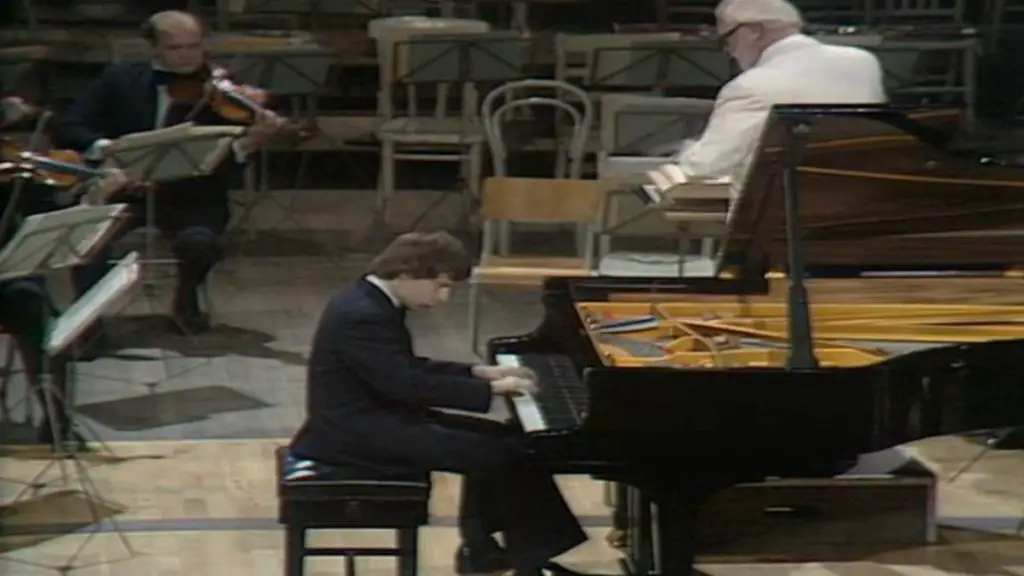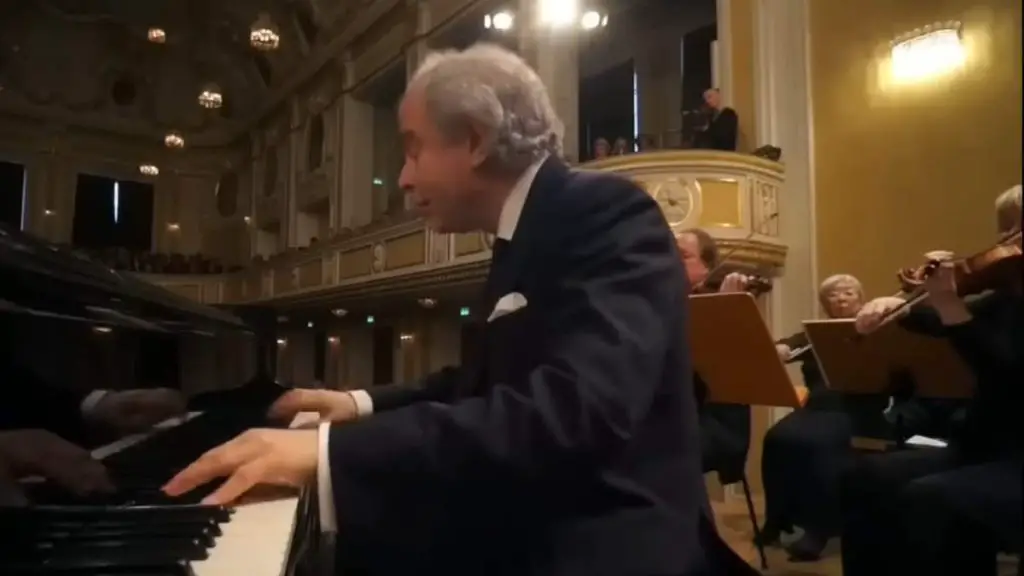Hungarian-born British classical pianist and conductor Sir András Schiff plays Johann Sebastian Bach’s English Suites, BWV 806–811, a set of six keyboard suites that the German composer wrote for the clavier (harpsichord or clavichord). They are generally thought to be the earliest of his 19 suites for keyboard.
Johann Sebastian Bach’s English Suites
Originally, their date of composition was thought to have been between 1718 and 1720, but more recent research suggests that they are likely to have been composited earlier, around 1715, while the composer was living in Weimar.
Bach was obliged to write a new cantata every week during his time at the Weimar court, and the English Suites he composed at this time expressed Bach’s longing for new, instrumental music and held, therefore, a very special place in Bach’s life and work.
Later in Köthen and Leipzig, he worked on a full-time basis with professional orchestras, providing him an ideal context in which to create orchestral and purely instrumental compositions.
Like the French Suites, the use of the term English to describe the Suites was a later addition. The name is thought to date back to a claim made by the nineteenth-century Bach biographer Johann Nikolaus Forkel that they were composed for an English nobleman, although no evidence has emerged to substantiate this claim. There are several striking characteristics of the English Suites.
Bach includes a highly virtuosic prelude for each, in a departure from the prevailing tradition dictating a strict progression of the dance movements (Allemande, Courante, Sarabande, and Gigue). By comparison, the later French Suites and Partitas are less strict in form. The Sarabande and Gigue movements in each of the English Suites are never separated by more than a single (twinned) Menuet or Menuet-like movement. Finally, the English Suites are predominantly in the minor key.
Structure
The structure of Bach’s English Suites adheres to the traditional Baroque suite format, generally commencing with a Prelude followed by a series of dance movements. Typical dance forms like Allemande, Courante, Sarabande, and Gigue are almost always present, often interspersed with additional dances like Minuets, Bourrées, or Gavottes.
Unlike the simpler French Suites, the English Suites usually begin with an elaborate Prelude that can be quite expansive and intricate, setting the stage for the complexity to follow. These Preludes serve as more than mere introductions; they are often full-fledged compositions rich in thematic material and counterpoint. The dance movements that follow are diverse in tempo and character but are united by a common key. While the English Suites do conform to a general pattern, each suite is unique in its details, showcasing Bach’s ingenuity in varying the traditional forms.
With starting times in the video:
- Suite No. 1 in A major, BWV 806 00:00
- Prelude. A prelude is a short piece of music, the form of which may vary from piece to piece.
- Allemande. An allemande (allemanda, almain(e), or alman(d), French: “German (dance)”) is a Renaissance and baroque dance, and one of the most popular instrumental dance styles in baroque music, with notable examples by Couperin, Purcell, Bach, and Handel. It is often the first movement of a baroque suite of dances, paired with a subsequent courante, though it is sometimes preceded by an introduction or prelude.
- Courante I. The courante, corrente, coranto, and corant are some of the names given to a family of triple meter dances from the late Renaissance and the Baroque era. In a Baroque dance suite, an Italian or French courante is typically paired with a preceding allemande, making it the second movement of the suite or the third if there is a prelude.
- Courante II
- Double I. The double variation (also known as alternating variations) is a musical form used in classical music. It is a type of theme and variation that employs two themes. In a double variation set, a first theme (to be called A here) is followed by a second theme (B), followed by a variation on A, then a variation on B, and so on with alternating A and B variations. Often there is a coda at the end.
- Double II
- Sarabande. The sarabande (from French sarabande, itself derived from Spanish zarabanda) is a dance in triple meter. Johann Sebastian Bach sometimes gave the sarabande a privileged place in his music, even outside the context of dance suites; in particular, the theme and climactic 25th variation from his Goldberg Variations are both sarabandes.
- Bourrée I. The bourrée (also borrèia and, in England, borry or bore) is a dance of French origin and the words and music that accompany it. The bourrée somewhat resembles the gavotte, it is in double time and often has a dactylic rhythm but it is somewhat quicker and its phrase starts with a quarter-bar anacrusis or “pick-up” whereas a gavotte has a half-bar anacrusis. In the Baroque era, after the Academie de Dance was established by Louis XIV in 1661, the French court adapted the bourrée, like many such dances, for the purposes of concert dance. In this way, it gave its name to a ballet step characteristic of the dance, a rapid movement of the feet while en pointe or demi-pointe, and so to the sequence of steps called pas de bourrée. The bourrée became an optional movement in the classical suite of dances, and J.S. Bach, Handel, and Chopin wrote bourrées, not necessarily intending them to be danced.
- Bourrée II
- Gigue. The gigue is a lively baroque dance originating from the British jig. It was imported into France in the mid-17th century and usually appears at the end of a suite. The gigue was probably never a court dance, but it was danced by nobility on social occasions and several court composers wrote gigues. In Bach’s gigues, each section often begins as a fugue, in which the theme used in the first section is inverted in the second section.
- Suite No. 2 in A minor, BWV 807 20:35
- Prelude
- Allemande
- Courante
- Sarabande
- Bourrée I
- Bourrée II
- Gigue
- Suite No. 3 in G minor, BWV 808 39:45
- Prelude
- Allemande
- Courante
- Sarabande
- Gavotte I. The gavotte (also gavot or gavote) is a French dance, taking its name from a folk dance of the Gavot, the people of the Pays de Gap region of Dauphiné in the southeast of France, where the dance originated according to one source. According to another reference, however, the word “gavotte” is a generic term for a variety of French folk dances, and most likely originated in Lower Brittany in the west, or possibly Provence in the southeast, or the French Basque Country in the southwest of France. It is notated in 4/4 or 2/2 time and is usually of moderate tempo, though the folk dances also use meters such as 9/8 and 5/8. In late 16th-century Renaissance dance, the gavotte is first mentioned as the last of a suite of branles. Popular at the court of Louis XIV, it became one of many optional dances in the classical suite of dances. Many were composed by Lully, Rameau, and Gluck, and the 17th-century cibell is a variety. The dance was popular in France throughout the 18th century and spread widely. In early courtly use, the gavotte involved kissing, but this was replaced by the presentation of flowers. The gavotte became popular in the court of Louis XIV where Jean-Baptiste Lully was the leading court composer. Gaétan Vestris did much to define the dance. Subsequently, many composers of the Baroque period incorporated the dance as one of many optional additions to the standard instrumental suite of the era. The examples in suites and partitas by Johann Sebastian Bach are well known.
- Gavotte II
- Gigue
- Suite No. 4 in F major, BWV 809 57:05
- Prelude
- Allemande
- Courante
- Sarabande
- Minuet I. A minuet (also spelled menuet), is a social dance of French origin for two people, usually in 3/4 time. The word was adapted from the Italian minuetto and French menuet, possibly from the French menu meaning slender, small, referring to the very small steps, or from the early 17th-century popular group dances called branle à mener or amener.
- Minuet II
- Gigue
- Suite No. 5 in E minor, BWV 810 1:15:05
- Prelude
- Allemande
- Courante
- Sarabande
- Passepied I. The passepied (“pass-foot”, from a characteristic dance step) is a French court dance. Originating as a kind of Breton branle, it was adapted to courtly use in the 16th century and is found frequently in 18th-century French opera and ballet, particularly in pastoral scenes, and latterly also in baroque instrumental suites of dances. In English, the passepied has been called “paspy”, a phonetic approximation of the French pronunciation.
- Passepied II
- Gigue
- Suite No. 6 in D minor, BWV 811 1:35:00
- Prelude
- Allemande
- Courante
- Sarabande
- Double
- Gavotte I
- Gavotte II
- Gigue
Sources
- English Suites (Bach) on Wikipedia
- Prelude (music) on Wikipedia
- Allemande on Wikipedia
- Courante on Wikipedia
- Double variation on Wikipedia
- Sarabande on Wikipedia
- Bourrée on Wikipedia
- Gigue on Wikipedia
- Gavotte on Wikipedia
- Minuet on Wikipedia
- Passepied on Wikipedia

